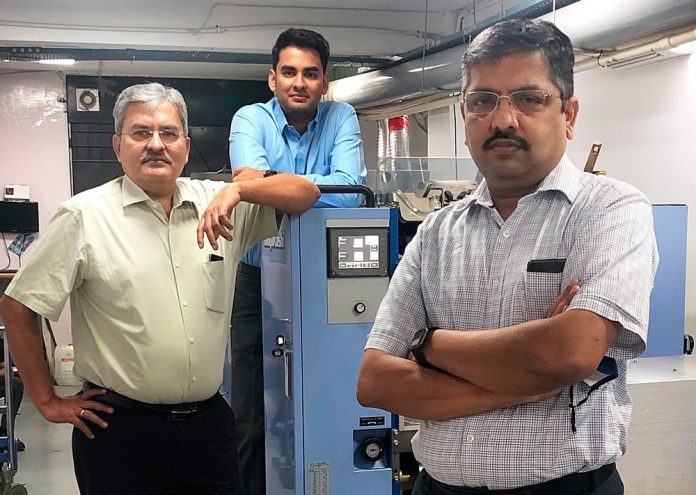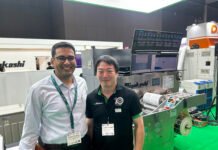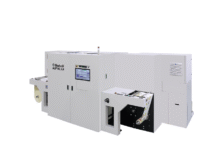
At the Provin stand at the last Printpack exhibition at the beginning of 2019, the web-fed Miyakoshi hybrid flexo and offset label press was shown. Subsequently, the press was installed in the demo center at Provin’s office in the Okhla industrial area in South Delhi for demonstrations and training purposes. Since it is a relatively novel technology and concept, it made sense to invest in a local demonstration and training center for the intermittent offset and flexo hybrid label press.
Although I call it novel, the concept is not entirely new. We have seen Chinese made stop-and-start or intermittent web-fed offset presses at label shows, including the Labelexpo India at Pragati Maidan almost a decade ago. However, although label converters have recognized the ease of making high-resolution and speedier offset prepress and plates at lower costs, they have often been disappointed by the eventual throughput of some of the intermittent label presses purchased and installed.
The key to offset reproduction is in the feeding
As a sheetfed and web offset printer and trainer, I have generally tried to explain (to those press operators who would listen) that the key to quality reproduction, whether on a sheetfed or webfed offset press, is in the feeding. If the feeding is not steady and if the movement through the press is not smooth and the delivery struggles, or in the case of webs create the right pull, the reproduction and the ink-water balance cannot be maintained adequately. You will find up either with weak printing or too much ink or misregister, leading to mud on the substrate and many other reproduction errors and artifacts.
There are extra problems for maintaining equilibrium in the system on a label press, especially one that allows varying print lengths without changing any cylinders. The first is the need to print on pressure-sensitive label stocks, including film substrates or face stocks, since they are non-absorbent for the curing or drying of ink. And the second is the problem of the back and forth movement of the labelstock web, which allows the use of various print lengths without changing cylinders (called tooling). A third possible problem would be the rotary die-cutting unit that could stress the offset ink transfer if it resulted in any tension change as the substrate moves through each printing unit.
The solution to the first problem of printing on film face stock is quite ordinary and simple – the use of UV inks and, in Provin’s Miyakoshi press, using a Multiwave LED UV curing system. This is a typical method and allows the use of UV inks commonly used for offset cartons since they are are tolerant of dampening solutions. The Multiwave LED curing system used on the Miyakoshi at Provin means that the lamp can cure both conventional and LED UV inks. The LED variable radiation lamp has a longer life and does not require elaborate chilling and circulation for cooling. (The two flexo units on the press use conventional UV.)
The solution to both the infeed and out-feed problem and the back and forth movement of the web to compensate for varying run lengths with same circumference cylinders is Miyakoshi’s ingenious air-driven loop. Before the take-up reel, there is one air-driven loop before the first printing unit and another air-driven loop at the end of the press. There is a web tensioning unit also after the infeed air loop.
The infinitely variable loop is created by air pressure, and it shrinks and lengthens as the web moves back and forth in the press units to compensate for the longer and shorter print lengths on the standard-sized offset plate. To a person who admires stream feeders and has seen many kinds of splicers and festoons on web in-feeds, this is an ingenious feat of automation, worthy of a tech innovation award.
The die-cutting unit’s problem is not a problem since this press uses a magnetic rotary die-cutting unit to which flexible dies are attached and matches the overall press speed. (This is a bit unlike some intermittent label presses seen in the past, which used a flatbed die-cutter.)
The Miyakoshi MLP 13C at Provin Technos
The intermittent or back and forth substrate moving web offset label press in Provin’s demo center is called the semi-rotary MLP 13C, and it has two flexo units and five offset printing units. Provin also uses the fifth printing unit as a coater. The press also has a de-lam and re-lam unit. The press runs and performs – it prints and die-cuts saleable labels at the rated speed of 70 meters a minute. It is being run and demonstrated on 50-micron and thicker films without chilled cylinders. (For thinner films, additional chill rollers would be required.) The press also has a BST Eltromat AR 4000 auto-registration system and Miyakoshi’s own auto ink-keys.

In the lockdown days, Provin is running the press for more than just training and demonstrations. It provides a back-up for commercial and label printers by printing, slitting, and rewinding labels in a complete production setup. It outsources the offset plates at the very nominal cost of Rs. 50 a plate. The press is eminently productive and profitable for short runs of anywhere from 150 to 500 label stock meters. The advantage of offset over digital would be that you could also do much longer runs of 2,000 to 30,000 meters on such a press.
The CAPEX for a Miyakoshi press may be higher than a narrow web flexo label press but keep in mind that you need to buy extra tooling for a flexo press to run various print lengths, and you may need several of these. Secondly, calculate the price of making flexo plates, especially for a new design or prototype for a brand owner. The time and effort of changing the tooling or cylinders and aniloxes for the print length and ink densities also have a price.
Then compare the quality and ease of operation of offset and flexo and what you can do with CYMK and one special color on offset, compared to an 8-color flexo press. (Here, keep in mind that there are possible advantages in both processes and that I am an experienced offset printer. Although trained by DuPont on flexo platemaking, I have nil experience in running a flexo press.)
Since the Provin Technos office has the Miyakoshi running in its demonstration center, you can make an appointment and see it in Okhla in New Delhi. I don’t normally advise anyone for free, let alone to buy a press, but before you think of purchasing a digital label press, I urge you to see this operation live. In case you would like to buy such a press, my free advice is to buy the brand you see in a live demonstration to avoid disappointment with other presses that may claim to be similar.
(If you get this far, you may also call the man, and he often responds to phone calls to his landline. The man’s name is Narendra Paruchuri, who bought a Miyakoshi semi-rotary a couple of years ago.) According to Vinay Kaushal of Provin Technos, “A label printer should have a variety of tools. While the semi-rotary offset could be the first press for commercial printers going into labels, it is an essential tool for other label converters.”











